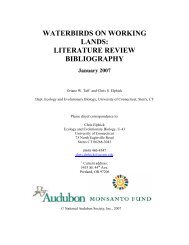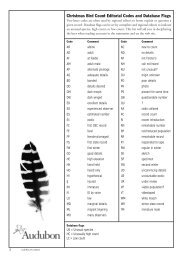audubon strategic plan 2012-2015
AUDUBON STRATEGIC PLAN 2012-2015 - National Audubon Society
AUDUBON STRATEGIC PLAN 2012-2015 - National Audubon Society
- No tags were found...
Create successful ePaper yourself
Turn your PDF publications into a flip-book with our unique Google optimized e-Paper software.
exeC utivesummaryLook for these icons throughoutthe <strong>strategic</strong> <strong>plan</strong>.Conservation StrategiesAudubon will maximize our conservation results by focusingon five conservation strategies critical for birds.Putting Working Lands to Workfor Birds & PeoPLeBest management practices on ranches, farms, and forests hold the key to survival formore than 150 species of threatened grassland and forest birds. By partnering withlandowners, Audubon can help ensure a bright future for birds like the Cerulean Warblerand the Tricolored Blackbird, and a healthy landscape for future generations.sharing our seas & shoresCoastal areas are a magnet for birds and people alike. Unfortunately, overfishing, development,and sea level rise put 60 percent of coastal birds at risk. By expanding our successfulcoastal stewardship program, Audubon can enlist a growing army of volunteer caretakersof nesting habitat. Seabirds are also vulnerable—they make up close to half the specieson Audubon’s WatchList. By incorporating marine sites into our Important Bird Areasprogram, Audubon can advance policies and practices that will reduce threats such asoverfishing and pollution from oil and other causes.saving imPortant Bird areasKnowing which places are most important for birds is the first step toward conservingthem. Audubon has identified 2,544 Important Bird Areas in the United States,covering 378 million acres, and is supporting work in some of the 2,345 IBAs in LatinAmerica, the Caribbean, and Canada. Now we can harness the Audubon network toprotect, restore, and advocate for these landscapes and the birds that depend on them.shaPing a heaLthy CLimate& CLean energy futureClimate change poses an unprecedented threat not just to birds but to biodiversityand our shared quality of life. Audubon is responding to this challenge with an equallyunprecedented combination of strategies, from advancing transformational policies thatreduce carbon emissions and support well-sited green energy to leading adaptive landmanagement practices that will mitigate the impact of sea level rise and climate change.Creating Bird-friendLy CommunitiesMost Americans live in cities or suburbs, and people can play a critical role in fosteringhealthy wildlife populations and communities. Rural regions have an outsized opportunityto contribute. As the leading voice for birds, Audubon can inspire the one in five adultswho watch birds to make daily lifestyle choices that add up to real conservation impact.Open the gatefold at right to see how we are advancing ourConservation Strategies in each Flyway of the Americas.3How w e w ork: following t H e flyways to HemispH eric c onservati o nconServAtion StrAtegieS PAcific fly wAy centrAl fly wAy miSSiSSiPPi fly wAy AtlAntic fly wAyPutting working lAndSto work for birdS & PeoPleShAring ourSeAS & ShoreSSAvingimPortAnt bird AreASShAPing A heAlthy climAte& cleAn energy futurecreAting bird-friendlycommunitieSthe bottom line:118 million Acres64 Priority Speciestransforming the central valley(page 24)tongass national forest(page 26)coastal Stewardship: Pacific(page 27)Saving Seabirds: Pacific(page 30)Arctic Slope(page 28)Across all flyways:Improve energy <strong>plan</strong>ning/siting to minimize impacts on priority birds and landscapesSupport climate policy solutions, efficiency policies, and renewable energy incentives; eliminate dirty coalDrive effective policy and practice through expertise about birdsHelp birds adapt to climate change through lobbying, modeling, and adaptation strategyAcross all flyways:Audubon At Home; Urban Oasis; TogetherGreen; Lights OutCitizen-science monitoring (e.g., Christmas Bird Count, Great Backyard Bird Count)Mobilize Chapters and Centers to acquire and restore critical habitats, and to engage a broad audienceNurture Important Bird Areasiconic bird species: Snowy Plover,Western SandpiperFor full list of Pacific Flyway priority bird species,see page 22migration corridor(page 36)Sagebrush ecosystem(page 34)Prairie birds (*Incubator project)(page 40)coastal Stewardship: gulf(page 44)western rivers (*Incubator project)(page 41)iconic bird species: Sandhill Crane,Greater Sage-GrouseFor full list of Central Flyway priority bird species,see page 32bottomland forests(*Incubator project)(page 49)Prairie birds (*Incubator project)(page 40)coastal Stewardship: gulf(page 44)mississippi river delta(page 46)iconic bird species: ProthonotaryWarbler, Black SkimmerFor full list of Mississippi Flyway priority birdspecies, see page 42eastern forests(page 52)eastern grasslands &Shrublands (*Incubator project)(page 59)coastal Stewardship:Atlantic & gulf(page 54)Saving Seabirds: Atlantic(page 58)everglades ecosystem(page 56)long island Sound(page 57)Saltmarsh (*Incubator project)(page 59)iconic bird species: WoodThrush, Piping PloverFor full list of Atlantic Flyway prioritybird species, see page 504 Audubon StrA tegic PlA n*Incubator projects: Projects with clear and significant conservation potential that are pending additional assessment of feasibility and impact. Acre and species metrics for these projects are not included in the Bottom Line totals above.


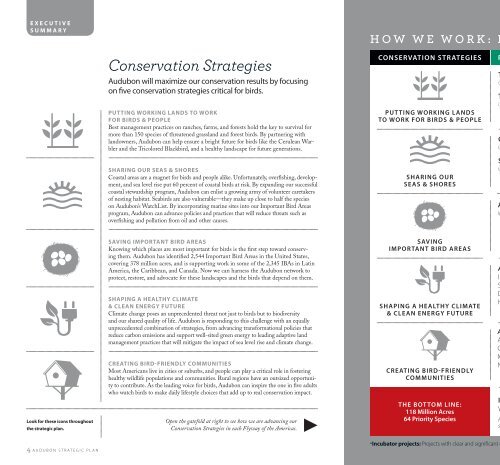



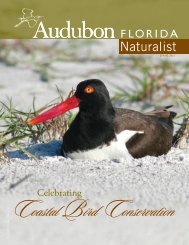
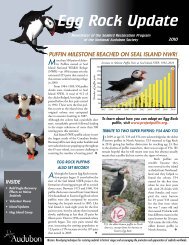
![Full report [PDF] - the Boreal Songbird Initiative](https://img.yumpu.com/52893853/1/190x259/full-report-pdf-the-boreal-songbird-initiative.jpg?quality=85)
